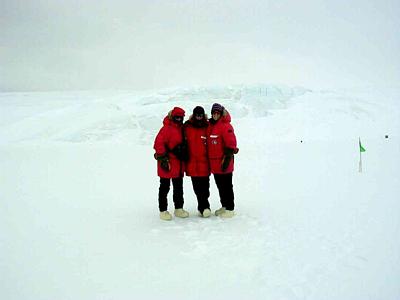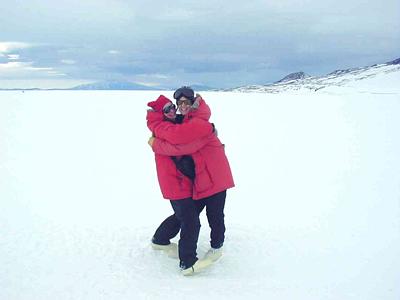
|
|
13 November, 1999
Ross Ice Shelf, Antarctica
Sleeping in a tent in Antarctica was not as cold as I expected it to be! I
assume that having the proper equipment was a plus! The only things that
got cold were my hands and feet and those problems were taken care of
easily. For my feet, I boiled water, poured it into my leakproof water
bottle, and put the bottle in the bottom of my sleeping bag! This kept my
feet warm and insured that I would have liquid water to fix for hot cocoa in
the morning! My hands were a little more difficult to take care of until I
discovered that the Kiwi military had handwarmers! Two soldier graciously
gave me a pair of handwarmers and I was toasty! The handwarmers stayed hot
until morning! The rest of me, snuggled in my sleeping bag, did not get
cold! The only problem with sleeping in a tent in Antarctica was the lack
of darkness! Again, I easily fixed this problem by pulling my hat over my
eyes! I slept until 7 a.m.!
After everyone was awake and we had our fill of hot cocoa, we disassembled
the tents, packed up everything, and waited for the Nodwell to pick us up
and take us to the jamesway, a hut on the ice. No one complained of having
been cold the night before. I think this was a testament to having the
right equipment and being prepared.
Our morning was set aside for learning how to correctly use a radio. When
you are in the field, your only contact with the rest of the world is by
radio. We were taught how to troubleshoot problems and what to say. I was
the first in my group to try the radio. "South Pole, South Pole, South
Pole, this is McMurdo Field Safety Training Program. How copy? Over." I
anxiously awaited a reply. Instead of South Pole Station answering, McMurdo
answered and told me to try another frequency. I was never able to get
South Pole but, we did speak to others. This lesson in radio use was so
important because in the case of an emergency, proper use of the radio could
mean life or death.
Our next task was role-playing in scenarios described by our instructors.
Our first scenario involved a trip in the Nodwell. Because we had to
retrieve some equipment, we had to drive the Nodwell to a storage building.
I asked if I could drive, thinking they would just laugh at me, when
instead, the brave instructor Bill said, "Sure!" I was dumbfounded! Now I
HAD to drive the Nodwell! Getting into the driver's seat was a challenge!
The seat sits almost 8 feet above the ground! There isn't a steering wheel.
There isn't a brake pedal. Instead, there are two levers, a gas pedal, and
a gear shift. Pulling on the left lever made the Nodwell turn left.
Pulling on the right lever, the Nodwell would turn right. Pulling on both,
the Nodwell stops. Bill told me to push the gas pedal all the way to the
floor! I put the Nodwell into gear, stepped on the gas, and slowly, the
giant vehicle maneuvered itself away from the jamesway. On the Ross Ice
Shelf, there aren't many things to hit. There are, however, crevasses.
These are cracks in the snow and ice that could be very small but, could be
large enough to eat a Nodwell. It was important that I keep the Nodwell on
the flagged path. Actually, it was very easy to drive and we arrived at our
destination safe and sound!
For our scenario, we were told that the Nodwell had caught on fire and that
we had to set up an emergency camp, including a tent and kitchen area, and
place an emergency call for help. Our group proudly completed all tasks in
eight minutes! Much to our dismay, the other group finished in just over
seven minutes!
Our next scenario involved a Kiwi soldier who, according to the
scenario,left an hour ago to use the toilet. He had not returned. It was
snowing so hard that a whiteout condition (that is, you can't see anything
in front of you) was in effect. To simulate this, everyone had to put a
white bucket on their head!
Answer to Thursday's question: This scenario illustrates the answer to my
question from Thursday. Each searcher took a bamboo pole in one hand
placing themselves a pole-length away from the person in front and behind
them. All searchers held onto a rope with the other hand. The lead
searcher tied one end of the rope to himself and the other to the jamesway.
Another person stayed behind to operate the radio. The lead searcher left
the jamesway, heading in the direction of the toilet. While the searchers
were walking, they continually moved their bamboo poles from side to side,
scanning the area. After all searchers were out of the jamesway and the
lead searcher had reached the toilet, the group began to move altogether in
a fan-like motion. They searched the area to the right of the toilet and
then to the left of the toilet. They finally found the Kiwi soldier (lying
in the snow very patiently) and carried him back into the jamesway. This
was a difficult assignment and illustrated to us what could happen in a
severe snowstorm! Wearing the buckets on our heads showed us what to expect
in a whiteout!
The final training that we received was about helicopter safety. We were
taught how to board and load a helicopter and what to expect from our pilot.
We are scheduled for our first helicopter trek on Wednesday and because
weather conditions change rapidly in Antarctica, we have to be prepared for
the worst situations.
In the evening we attended a party to which all of the residents of McMurdo
were invited! It was a fun event with music and food and dancing! Later,
Julie and I played pool and lost as usual. We'll get better with practice!
Today's question: What is the correct way to board a helicopter?
Sharon
JUST FOR KIDS!!!!! Sleeping in a tent in Antarctica was not as cold as I
expected it to be! The only things that got cold were my hands and feet.
To keep my feet warm , I boiled water, poured it into my leakproof water
bottle, and put the bottle in the bottom of my sleeping bag! Two soldiers
from New Zealand gave me their handwarmers to keep my hands toasty! The
handwarmers stayed hot until morning! The rest of me, snuggled in my
sleeping bag, did not get cold! The only problem with sleeping in a tent in
Antarctica was the lack of darkness! Again, I easily fixed this problem by
pulling my hat over my eyes!
We spent the day learning how to operate radios in case of an emergency. We
also played a game where we pretended that we had an emergency. Our
instructors wanted to make sure that we knew what we should do. In one of
the games, we had to wear white buckets on our heads! Now why do you think
we had to wear buckets? Well, this will answer your question from Thursday
about finding people lost in a snowstorm! We were pretending that we were
in a snowstorm and one of the soldiers was lost outside! This snowstorm was
so bad that it was a whiteout! In a whiteout, you can't see anything! The
buckets made us feel like we really were in a whiteout! With buckets on our
heads, we held onto a rope with one hand and a bamboo pole with the other.
As we walked outside, we swung the pole around trying to find the lost
person. The rope stayed tied to the hut so that we wouldn't get lost too.
Eventually, we found the lost soldier lying in the snow and carried him to
safety.
We also learned about helicopters. We were taught how to get on and off a
helicopter and how to put our equipment on the helicopter. We are scheduled
for our first helicopter ride on Wednesday!
Today's question: What is the correct way to get on a helicopter?
Sharon

Maite, Julie, and Sharon in front of ice fall. This picture does not indicate the enormous size of this ice fall!

Julie and Sharon are "happy campers".
Contact the TEA in the field at
.
If you cannot connect through your browser, copy the
TEA's e-mail address in the "To:" line of
your favorite e-mail package.
|
